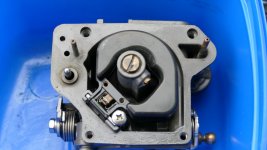Ok, yeah. Your carb manual was printed prior to this model carb.
1st edition?
No matter, I just won't reference the manual anymore.
All the fuel delivery orifices, idle, intermediate transition, and high speed, are located at the back of the top of the carb throat. All but the idle orifice are hidden when the throttle plate is closed.
This carb is most effectively cleaned when you can find a way to prop the throttle plate wide open. I use a small, pocket screwdriver inserted in the linkage to keep it open.
My technique involves using the plastic straw provided with the spray cleaner and carefully bending it 90° at one tip. You can then use it to get the tip directly over each orifice to "backflush" each part of the delivery circuit. I use the term backflush alot because it's necessary. Especially in a case like yours where it's obvious that you had water in fuel that then sat for too long.
I will tell you now that if you can't clear that primary jet, you may need a new carb.
If the jet won't clear with several tries, you might be able to more effectively flush it by removing the slow speed tube and flushing from the area of the oring. It's almost impossible to see in there but trial and error might get your 90° bent straw in that feed orifice.
You can also keep backflushing the idle, intermediate and transition orifices since they all lead back to that passage.
Also....at the front of the carb, on the mounting flange are the passages for the high speed and low speed air jets. Those lead directly into core of the carb and you might notice fluid exiting there when backflushing the orifices. Plugging those holes with your fingers can help raise the pressure in the passage to help get the blockage moving.
Actually, Plugging ANY fluid flow, from anyplace other than where you want it, helps increase internal pressure and it's something I have learned to do by using fingers and thumb while spraying.
As far as removing the idle screw, I have never understood why someone would attempt to clean a carburetor (especially one that won't start) and not do a thorough job of it. Yes, it can be difficult to remove the screw because the oring acts as a lock to hold it in. And, yes, it's very easy to break off the "false head" of the screw. But a very sharp pick tool used to pry while turning the screw gets them out every time for me.
But if you don't intend to replace the oring....which may be bad btw....don't bother disturbing it.
I would not even open one of these up if I didn't have, at least, a new gasket set that comes with the small orings for the slow speed tube and idle screw.
And, if you're inclined to replace the anti tamper cover for the idle screw, you will need a new screw set if you break off the old one.
You can remove the tamper cover without breaking the false screw head by heating it with a soldering iron while gently pulling with needle nose pliers.
I've read that some "just pop them off" but I never had luck doing it like that without breaking off the false head.
As to the accelerator pump circuit....
You have to verify that the nozzle in the delivery tube is COMPLETELY clear.
The brass tube juts out into the incoming air at the front of the carb. But you have to look into the rear of the carb throat to see the nozzle that faces rearward.
You test that nozzle like this:
Turn the disassembled main body upside down and locate the feed passage for the tube. It's right next to your plugged primary tube.
With the throttle plate propped wide open and the rear of the carb FACING AWAY FROM YOU...squirt carb cleaner into the feed hole and ensure that a stream of fluid SHOOTS out the rear of the carb a distance of approximately 8 feet. YES! 8 feet!
If it's less than that, you need to clean the nozzle by placing the tip of the plastic straw (a straight one) through the rear of the carb and carefully placing it over the nozzle orifice and BACKFLUSHING the nozzle and tube.
Test it again for an 8 foot stream and continue to backflush and retest until clear.
Glad to answer any questions.
Good luck.


